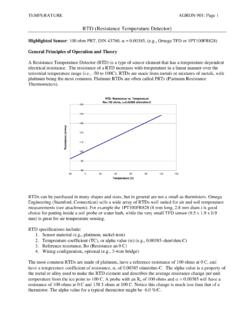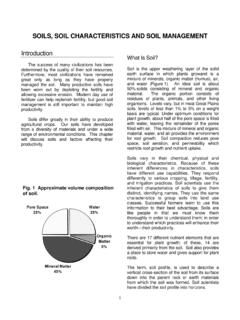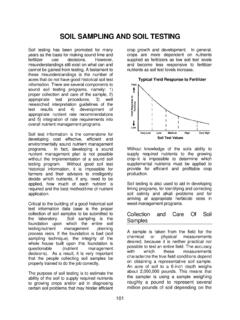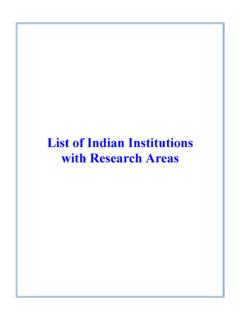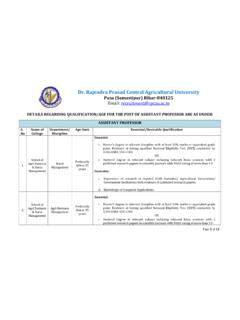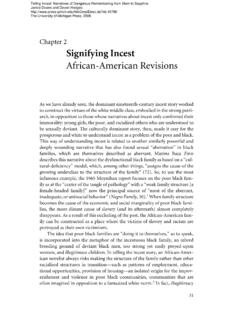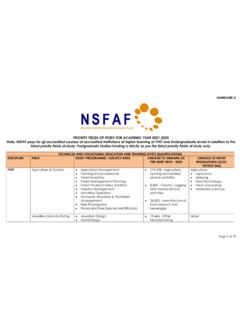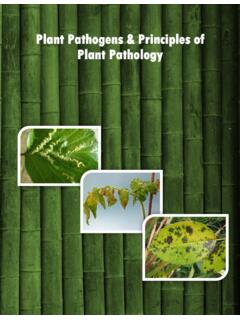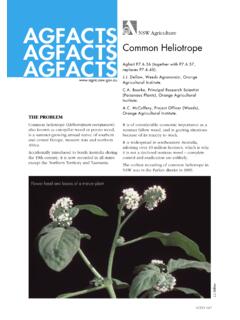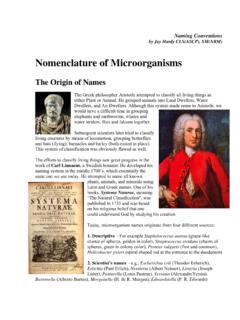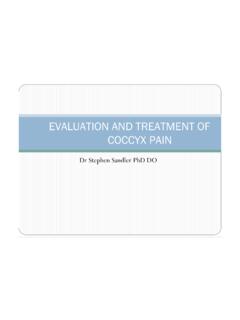Transcription of Corn Production Handbook - Kansas State University
1 CornProductionHandbookKansas State UniversityAgricultural Experiment Station And Cooperative Extension ServiceNutrient Management PhotosPhoto 1. Nitrogen deficiency (left) through nitrogen sufficiency (right). Photo 2. Nitrogen sufficient (left) nitrogen deficient (right).Photo 3. Early season phosphorus 4. Late-season phosphorus 5. Potassium 6. Potassium 7. Iron 8. Iron Management PhotosPhoto 9. Armyworm 10. Black cutworm 11. Black cutworm damage. Photo 12. Chinch 13. Corn earworm 15. Corn rootworm 16. Goose-necked corn from corn rootworm injury. Photo 14. Corn rootworm 17. European corn borer 18. Fall armyworm 19. Flea 20. Differential 21. Maize 22. seed corn 23. Southwestern corn borer Management PhotosPhoto 24. Southwestern corn borer and Development Stewart R. Duncan, Northeast Area Extension Specialist, Crops and Soils Dale L.
2 Fjell, Northeast Area Extension Director Richard L. Vanderlip, Research Agromomist, Crop Production (Emeritus) 3_____Select Hybrids Carefully Kraig L. Roozeboom, Extension Specialist, Crop Production /Cropping Systems Dale L. Fjell, Northeast Area Extension Director 7_____Optimum Planting Practices Kraig Roozeboom, Extension Specialist, Crop Production /Cropping Systems Dan Devlin, Extension Specialist, Environmental Quality Stewart Duncan, Northeast Area Extension Agronomist Brian Olson, Northwest Area Extension Agronomist Curtis Thompson, Southwest Are Extension Agronomist 10_____Nutrient Management Dale Leikam, Extension Specialist, Nutrient Management David Mengel, Professor, Soil Fertility and Nutrient Management 14_____Weed Management David L. Regehr, Extension Specialist, Weed Science Brian Olson, Northwest Area Extension Agronomist Curtis Thompson, Southwest Are Extension Agronomist 21_____Insect Management Jeff Whitworth, Extension Specialist, Entomology Phillip E.
3 Sloderbeck, Extension Specialist, Entomology 23_____Major Corn Diseases Douglas J. Jardine, Extension Specialist, Plant Pathology 25_____Irrigation Danny H. Rogers, Extension Specialist, Irrigation 30_____Harvesting Suggestions Randy Price, Extension Specialist, Farm Machinery 36_____Drying and Storing Joseph P. Harner III, Extension Agricultural Engineer Randall A. Higgins, Extension Specialist, Entomology (Decesased) 38_____Profit Prospects Michael Langemeier, Agricultural Economist 42 Contents Growth and DevelopmentThat corn crop that you re planning to harvest next fall, or the one you are reviewing to try to understand why yields were less or greater than expected, started when the seed was planted and ended when the ear was successfully harvested. Before planting, considerable planning and preparation goes into corn Production .
4 The crop you hope to produce is dependent on the genetic and environmental characteristics in which the plant was we understand how the corn plant grows, develops, and produces grain, we have a better chance of knowing what will affect plant growth and consequently how to manage the crop for best Production . Consider the age of the corn in terms of plant development rather than in days. With information regarding specific Production practices, the other sections of this publication, will be more easily s start with the seed . Corn seed is made up of three primary parts (Figure 1): the embryo from which the new plant will develop; the endosperm or starchy part, the energy source for germination and emergence until the plant can function on its own; and the pericarp, or seed coat, which protects both the endosperm and the embryo.
5 We want to start with seed that has a viable embryo, that contains suffi-cient stored energy to get the plant established, and that has an intact seed coat to prevent attack by disease , seed is planted in soil moist and warm (mid-50 degrees Fahrenheit or higher) enough to allow rapid germina-tion and emergence. With increased adoption of no-tillage and reduced tillage farming, planting dates are earlier, on average, than 20 years ago. The practice of planting early allows for more intensified and potentially profitable crop-ping systems. As a result of planting early, however, corn seed is often planted into very cool soils where the 2-inch depth temperature is often closer to the minimally acceptable (for germination) 50 degrees Fahrenheit than the optimum mid-50 degrees Fahrenheit or greater. This results in an extended time period to achieve emergence.
6 Regardless of planting date, an average of 125 growing degree days are required for emergence (Table 1). Growing degree days are calculated by subtracting 50 degrees Fahrenheit from the average daily temperature, then adding the daily growing degree days over time. The planting to emergence growing degree days should be calculated from soil temperatures at seed depth. Depth of planting influences the amount of growth necessary before the seedling can emerge from the soil surface and affect the time required from planting to emergence. Changes in planting depth affect the depth at which the seed (seminal) roots develop, but does not affect the depth at which the permanent (nodal) root system develops. Even though the seed roots anchor the plant and absorb water and nutrients for the first 2 to weeks, the young plant is living on reserves from the kernel until the nodal roots develop from the crown and take over.
7 When the collar of the first leaf (the round tipped, or thumb leaf ) emerges and is visible above ground, the plant is at stage V1. At that time, the seminal roots quit growing, and the nodal root system begins development. Until tasseling, the growth stage of the plant is designated by the number of leaves with visible collars. Although six or seven leaves may be visible on the corn plant when the collar of the fourth leaf is visible, the plant has only developed to stage V4. From stages V1 to V10, each new leaf will fully emerge for every 85 growing degree days. From V10 until final leaf emergence requires about 50 growing degree days per fully emerged the first 4 to 5 weeks after emergence, the plant continually develops new leaves from the growing point, which, for most of this period, is below or at ground level.
8 A total of approximately 20 leaves will be developed. During this time, root and leaf development progress rapidly. Nutrient uptake also is occurring rapidly. Since the growing point is still below the soil surface, a frost or hail may destroy the exposed leaf area, but likely would not kill the plant. This could be Pericarp Embryo Endosperm Figure 1. The primary parts of a corn 1. Approximate Growing Degree Days (GDD) required for a mid-season maturity corn hybrid to reach different growth stages from the time of - Emergence125V6 - Tassel initiation475VT - Tassel emergence1,150 Silking1,400R4 - Dough stage1,925R5 - Dent stage2,450R6 - Physiological maturity or black-layer2,7001 Adapted from Hoeft, et al. 2000. Modern Corn and Soybean Production . Page important when determining whether or not to replant following a late-spring frost or hail storm.
9 At stage V5 to V6 about 475 growing degree days, all of the leaves the plant will produce have started, the growing point changes and the tassel is initiated (Table 1). Ears are initiated shortly after the tassel. By growth stage V6, the nodal roots have become the main root system of the plant. Within a few days of tassel initiation, the stalk grows rapidly and the growing point is elevated above the soil surface where any damage could affect the growing point and kill the plant. During the following 4 to 5 weeks, rapid growth occurs with the remaining leaves increasing in size and producing the factory that produces the grain during the latter portion of the growth this period of rapid stalk growth, plant height increases dramatically, the developing tassel emerges (1,150 growing degree days - Table 1) from the whorl and continues developing until pollination occurs.
10 Rapid root development and nutrient uptake also occur so that at tasseling, less than half of the final weight of the corn plant has been developed. However, more than 60 percent of the nitrogen, 50 percent of the phosphorus, and 80 percent of the potassium have already accumulated in the plant. The grain producing capability of the plant is set/deter-mined during this particularly important time the flowering process, stress conditions have more effect on the timing of tassel development than they have on ear development. Under hot, dry stressful conditions, the tassel may develop and shed pollen before the ear and silk formation has been completed resulting in poor or incomplete pollina-tion. Silks will grow slowly and fail to emerge in time to be pollinated as well as being too dry to support pollen germina-tion and the complete growth of the pollen tube.


